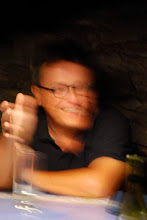Un terremoto di M 2.4 a profondità di 10 km sembra sia stato percepito in maniera così intensa da far sgombrare le scuole dell'Aquila. Almeno questo è quanto racconta la giornalista del TG1 alle 13 di ieri.
Diamo un'occhiata ai sismogrammi registrati dall'INGV a 5 km dall'epicentro. Sembra un normale, piccolo evento con una fase strong-motion delle S che non dura neanche 5 secondi.
A questo punto mi vengono in mente le seguenti motivazioni:
1) C'è stato il terremoto in Cile 3 giorni fa, ci voleva un evento in Italia per fare notizia.
2) La giornalista del TG1 è in zona l'Aquila da alcuni giorni inviando servizi sulle strutture, ed oggi non sapeva quale scoop inventarsi.
3) Anche la scala Mercalli-Cancani-Sieberg prevede (IV grado) che "questo movimento tellurico di solito non provoca paura nelle persone a meno che non siano nervose o apprensive a causa di terremoti precedenti".
4) elevate accelerazioni nel range di risonanza dell'essere umano (circa 25 Hz).
Non sto scherzando. C'è chi misura la frequenza di risonanza degli esseri umani, in piedi, sdraiati e seduti: http://journals.lww.com/spinejournal/Abs...5_Hertz.10.aspx
Spero che nessuno dica che serve per mirare le frequenze di HAARP al controllo mentale della specie umana. :-)
Più seriamente, il fatto che i giornalisti possano essere poco affidabili e che i terremoti ricevano o perdano attenzione a loro discrezione ha radici storiche ben profonde, come dimostra questo articolo:
CASTELLI V. and CAMASSI R.
Abstract
From their earliest beginnings in the 16th century, journalists never failed to find earthquakes interesting. As a result, early journalistic sources offer a huge hoard of original earthquake data, mostly untapped to this day for seismological purposes. In the aftermath of large earthquakes, the journalists of the 17th and 18th centuries tended to react in two ways. Either their interest for seismic news would increase, leading them to hunt for more news of the same kind, or it would focus exclusively on the big one to the detriment of lesser contemporary earthquakes. In the first case, it was possible that more earthquakes than usual would be given coverage; but in the second case more earthquakes than usual were likely to be overlooked and shadowed by the larger event. Through a comprehensive cross-check of Italian early journalistic sources, this paper attempts to highlight the shadow-zones of some major 17th-18th centuries Italian earthquakes.
Journal of earthquake engineering, 2005, vol. 9, pp. 333-348
Seismologists on trial in Italy
-
From Nature News blog:
Italian seismologists to be tried for manslaughter - May 25, 2011
*Posted on behalf of Nicola Nosengo*
Six Italian seismologists an...







Nessun commento:
Posta un commento